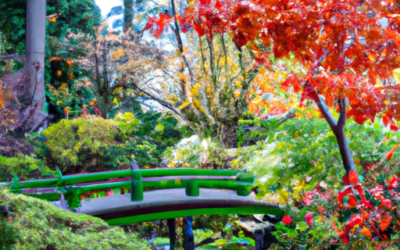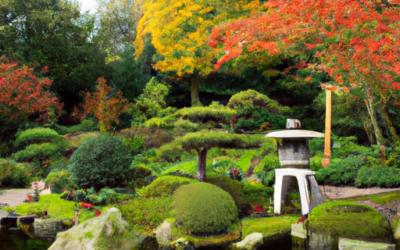Whether you’re on a quest for tranquility in the midst of bustling Los Angeles or simply craving a scenic backdrop for your next picnic, picture-perfect Japanese gardens are tucked away in this city, awaiting your discovery. Imagine your peace while traversing the arched bridges within Storrier Stearns Japanese Garden, absorbing the aura of the meticulously manicured Kyoto Gardens, or basking in the cherry blossom beauty of Descanso Gardens each spring. Awaken your senses with the curated bonsai collection at the esteemed Huntington Library, Art Museum & Botanical Gardens or revel in the gleam of lantern-lit walkways at the South Coast Botanic Garden. From the cultural wealth of Earl Burns Miller Japanese Garden on Cal State’s campus to the tucked-away tranquility of James Irvine Japanese Garden in Little Tokyo, these eight must-visit verdant havens provide an unforgettable exploration of L.A.’s captivating oriental oases.
Unveiling the Huntington Library, Art Museum & Botanical Gardens
Starting the journey, we find ourselves at the beautiful Huntington Library, Art Museum & Botanical Gardens. This destination in San Marino is an absolute treat, bringing together unique features including a beautiful bonsai collection, an impressively serene zen court, and a traditional five-room house.
Understanding the unique features of the garden
This Japanese garden has a distinct character making it a hit amongst the visitors. Feel the tranquility of the area as you stroll around the bonsai court that houses a collection of miniature, contemplative trees. In the Zen Court, experience serenity with the raked gravel garden signs of tranquility and mindfulness. The five-room house presents an opportunity to witness the traditional Japanese way of living.
A brief history of its establishment
Without a doubt, the Huntington Gardens is a well-crafted piece of art. Its diverse botanical collections and thriving art collections have their roots traced back to the 18th and 19th-century European and American art pieces.
Information on Cultural Programming
The garden runs numerous cultural programs throughout the year. Make sure you explore upcoming events on their website before your visit. These programs introduce visitors to Japanese culture beyond the garden and involve art exhibitions, concerts, and more.
Visiting Hours and Travel Tips
To relish this exquisite place, you want to know the best time to visit. The gardens open at 10 am and close at 5 pm. Aim to arrive at the opening time or in the late afternoon to avoid the crowd. Hats, sunscreen and water bottles are suggested in summer, while winter visitors might need an umbrella or raincoat.
Stepping into the Storrier Stearns Japanese Garden
A trip to Pasadena takes us to the Storrier Stearns Japanese Garden. Rich with history and tradition, this model of tranquility was first constructed in the late 1930s.
Basics of its Layout and Design
Unique in design, this Japanese garden features two wonderfully calm ponds, four ornate bridges, and a cascading waterfall. Each element intricately designed and placed to provide a complete Japanese garden experience.
Origins and Historical Background
The Storrier Stearns Japanese Garden is a cultural landmark, born in the late 1930s. The gardens were built by Kinzuchi Fujii, the last master gardener of Japan living in California during World War II. Though initially a private estate, it’s now open to the public since 2015.
Cultural Activities Hosted in the Garden
Storrier Stearns hosts numerous cultural activities revolving around tea ceremonies, enrichment lectures, workshops, art exhibitions, and concerts.
Tips for a Memorable Visit
Membership is an excellent choice for frequent visitors. The garden encourages slow-paced, peaceful walks where one can absorb the tranquility and beauty without hurry. Remember to respect the quiet atmosphere and avoid loud conversations and music.
Experiencing the Tranquility of Descanso Gardens
Moving on to La Cañada Flintridge where the radiant Descanso Gardens are awaiting explorers. Known for their stunning natural beauty, these Southern Californian gardens have a beautiful Japanese garden.
Highlighting the Key Japanese Features
The Japanese garden, with its tranquil atmosphere and beautiful cherry blossoms, is a significant section of Descanso Gardens. It incorporates features like an arched moon bridge, koi ponds, a bird watcher’s habitat, and the spring’s spectacular cherry blossoms.
Tracing its Botanical Journey
It began as a Spanish ranch and transformation into a public garden started in the 1950s. In 1966, the Japanese garden was added. Imagine the garden has been expanding and beautifying over the past fifty years.
Events and Activities in the Garden
Descanso Gardens is unique with their season-specific activities. Keep an eye on their event calendar for activities suitable to your interests – the majority focusing on horticulture, art, and culture.
Practical Information for Tourists
For your visit, consider wearing a good pair of walking shoes as the garden spreads across on 150 acres. Always check the weather conditions before heading there.
Wandering through The Japanese Garden, Van Nuys
Located in Van Nuys, The Japanese Garden offers a unique blend of aesthetics, tranquility, and insights into water preservation.
Exploring its unique Japanese elements
Visitors can enjoy the sight of stony bridges, well-kept trees, tea houses, and footpaths. With its 6.5-acre area and walkability, it offers the perfect environment for peaceful strolls and meditation.
The garden’s connection to water preservation
What sets this garden apart is its devotion to water conservation, making it an excellent educative destination too. The garden utilizes reclaimed water from the adjacent Tillman Water Reclamation Plant, making it an exemplary site of sustainable gardening.
Cultural engagements and community role
The garden plays an active role in cultural engagements by hosting traditional tea ceremonies and has been a preferred site for many film and TV productions.
Advice on visiting arrangements and timing
The garden is open from Monday to Thursday and on Sunday. A single-entry ticket is reasonably priced with discounted rates for seniors, students, and children. Don’t forget to check guidelines for a smooth visit.
Immersing in the Cultural Vibe at Earl Burns Miller Japanese Garden
Located on the Cal State Long Beach campus, the Earl Burns Miller Japanese Garden offers a rich exposure to Japanese aesthetics and culture.
The Japanese aesthetic in the garden
This beautiful garden offers a variety of authentic Japanese plantings, koi-filled ponds, and a zig-zag bridge which provides different views of the garden as you cross it. An incredible Tea House adds to the peaceful and cultural nature of the garden.
Exploring its university campus setting
The garden is an integral part of the university’s educational mission, offering a place for reflection and tranquility as well as promoting an understanding and appreciation of Japanese culture.
Cultural events and opportunities
A host to a variety of cultural programs and events such as Garden Walks, Tea House Storytelling, and even Moon Viewing Parties, the Earl Burns Miller Japanese Garden provides varied opportunities for cultural exposure.
Important travel details and suggestions
Open Tuesday through Friday, and on Sunday. The garden is only a short walk from the Brotman Hall visitor lot, but remember that on-campus parking permits are required. Comfortable shoes for walking and a camera are advisable.
Discovering the Hidden Beauty of Kyoto Gardens
In the hustle and bustle of Downtown, there’s a hidden jewel atop a high-rise hotel’s parking garage – the Kyoto Gardens.
Presenting the garden’s distinct features
This delicate, well-kept garden features an attractive waterfall, a small pond filled with colorful koi, and beautifully manicured trees and plants. Nested among the high-rises of downtown LA, it offers a tranquil retreat from urban life.
Digging into its origins and uniqueness
Kyoto Gardens are a homage to Los Angeles’s sister city, Kyoto, and are crafted to mirror the tranquility and peace of traditional Japanese gardens.
Announcements on Programs and Initiatives
The garden doesn’t regularly host cultural programs but is a popular place for quiet relaxation, meditation, and photography.
Useful tips for prospective visitors
Being part of the Doubletree by Hilton hotel, access to the garden is free, but keep in mind that parking might have a fee.
Reveling in the South Coast Botanic Garden’s Charm
The South Coast Botanic Garden offers numerous global inspirations under one roof, including an enchanting Japanese section.
Appreciating its Japanese-inspired sections
What truly stands out in this diverse garden is a serene Koi pond complete with waterfalls and captivating lanterns. The Japanese space is painstakingly designed and maintained to ensure that it stays true to its roots.
Unraveling the journey of its establishment
Once a sanitary landfill, the South Coast Botanic Garden is now a flourishing botanic beauty spanning 87 acres. It was one of the first to be developed over a landfill in the world.
Information on Cultural and Botanical Programs
The garden plays host to a spectrum of cultural events ranging from art exhibitions to concerts and botanic programs.
Essential Travel Information and Etiquettes
The garden is open every day of the year, and parking is free. The garden urges visitors to stay on the designated paths to avoid harming the flowers, plants, and wildlife.
Finding Peace in the James Irvine Japanese Garden
Tucked away inside the Japanese American Cultural and Community Center in Little Tokyo, the James Irvine Japanese Garden stands as a serene oasis.
Deconstructing its Japanese design elements
The elements of this garden embody tranquility and serenity typical of traditional Japanese design. Ponds filled with koi fish, a cascade and stone lantern are key contrasting features here.
Story of its creation and subsequent growth
Created as a token of gratitude towards the Los Angeles, the garden was named after the philanthropist James Irvine who contributed greatly to the establishment of the JACCC.
Details on hosted Cultural and Community Events
The garden frequently hosts cultural events, weddings, and other celebrations. It’s a social hub, promoting a sense of community among visitors.
Travel advice for first-time visitors
A humble reminder for visitors here is to maintain the tranquility of the garden by respecting its silence.
Understanding the Common Elements of Japanese Gardens
Let’s dive into the significance of various elements commonly found in Japanese gardens as we wrap up this garden tour.
The Significance of Koi Ponds
Koi ponds symbolize prosperity and good luck. They also embody aesthetic and serene landscape designs that promote relaxation and escape from mundane routines.
The Symbolic Meaning of Arched Bridges
Arched bridges often portray a spiritual crossing from the real world to a utopian world. It shows the contrast between the two sides of the journey.
The Role of Traditional Teahouses
Teahouses often serve as areas for gatherings or celebrations. It’s where the Japanese tea ceremony, an elegant and quintessential Japanese cultural experience, is conducted.
The Varied Forms and Meanings of Plants and Trees
Each plant and tree in a Japanese garden carries meaning. Cherry blossoms represent transience of life, while pines symbolize longevity and eternal youth.
Planning Your Visit to Los Angeles’ Japanese Gardens
Before you head on your journey, a little planning can ensure a smooth and enjoyable experience.
Best Time of Year to Visit
Spring is an excellent time to visit, as gardens are in full bloom. But fall is equally striking when the leaves change color.
Packing Essentials for Maximum Comfort and Enjoyment
Ensure weather-appropriate clothing, sunscreen or umbrella, a hat, comfortable walking shoes, and refreshments. A camera to capture the beauty is also a good idea.
Travel Considerations and Accommodations
Depending on your plans, accommodations can vary. Staying closer to your most anticipated gardens might make your trip more convenient.
Budgeting Your Trip Effectively
Factor in entry fees, food, accommodation, and additional costs of cultural activities. Public transport or driving rentals might save you some bucks.
With that, you are ready to embark on your enlightening journey, immersing yourself in the allure of Los Angeles’ stunning Japanese Gardens. Let the tranquility of these spaces captivate you as you step into a world of natural beauty and serenity.








